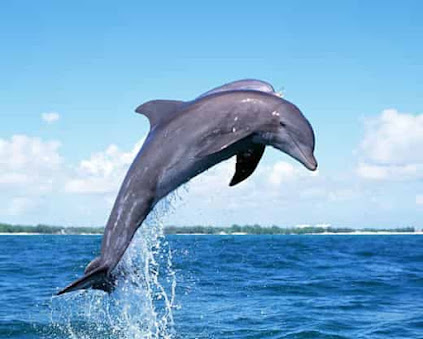Essay about Dolphin
Introduction

Dolphin is an aquatic animal belongs to the mammal
family Delphinidae. In Delphinidae family has nearly 40 species of dolphins
including the killer whale and pilot whale. Scientific name is Delphinus
delphis. Whales and dolphins evolved from Pakicetus, a furry mammal that roamed
the earth 50 million years ago. The word dolphin is related to the ancient
Greek word “womb”. The Greeks called the dolphin “Womb fish”.
Description of Dolphin
Dolphin has spindle-shaped body with non-flexible neck. Their limbs modified into flippers also called pectoral fins and are mostly used for steering. On its back, has a dorsal fin which acts like the keel on a boat, provides stability to its body. The two fins called flukes and propels make the dolphin’s tail. The length of the dolphin is 1.7m and the weight up to 22000 pounds. Killer whale, false whale and pilot whale are the largest members of the dolphin family and Maui’s dolphin is the world’s smallest dolphin. They have two small eyes on the both sides of their heads and they do not have external ear flaps. Their long snout which is called rostrum is used to probe the ocean floor for hidden fish. Dolphin has conical-shaped teeth inside the rostrum. They have blowholes at the top of their head which they use to breathe when reach the water surface. They have blubber, a layer of fat under their skin, that keep them warm. Its large fatty forehead is called melon. They have awesome eyesight both in and out of water. Some marine-life researchers believe that dolphins are basically color-blind. They are not able to enter fill sleep mode and sleep with one eye open.
Dolphin’s Habitat
Dolphins are found all over the world. They live in
moderate to warm oceans, seas, bays, gulfs, harbors and the areas where the
rivers meet the sea (estuaries). They
are also found in Black Sea and Mediterranean Sea. Dolphins
live in groups, which is called “school” or “pod”.
Dolphin’s Diet
As dolphin live along coastal areas, they eat fish, crab, octopus squid, shrimp, crab, jellyfish etc. which is found on the coastal bottoms. Bottlenose dolphins prefer to eat different species of fish including catfish, Moray eel, mullet, Salmon. They eat about 15 to 25 pounds of food each day. They do not chew their food but swallow the whole but the salty water is force out of their mouth. They obtain the fresh water from their food such as fish, crab, shrimp, squid etc. Dolphins have no sense of smell as they have no olfactory lobs. They have no taste buds so they have no sense of taste but prefer to different kinds of fish.
Behavior of Dolphin

Most dolphins are very playful and active. They like to play with objects and other dolphins. Dolphins can jump up to 4.9m above the water surface and can make bubble rings. To save energy, swim on the surface of the water, or
jump on the water, since there is less friction in the air. This type of travel
is called porpoising. Not only energy saving, other reasons are orientation,
social performance, fighting, non-verbal communication, entertainment, and
attempts to dislike parasites. They are good
swimmers and can swim up to 18 miles per hour. Dolphins
have large and highly developed brain so they are very intelligent and smart
animals. They display self-awareness,
problem-solving, empathy, innovation, teaching skills, sadness, happiness, and
curiosity.
Female dolphin gives birth one baby or calf every 1 to 6 years. The length of the calf is 39 to 53 inches and the
weight is 22 to 44 pounds. The new born calf suckles thick milk from its
mother. The other members of the pod defend
the calf and they surround the calf for protecting it from killer whales and
the sharks.
Threat to Dolphin
In many parts of Asia, Africa and South America
dolphins hunt occur. Dolphins are killed for food and the fishermen killed the
dolphins as they damage fishing nets. The
water pollution is the other cause for the extinction of dolphins. Due to
climate change and global warming, the birth rate of dolphins in Shark
Bay Western Australia has decreased. Some species of dolphins are
seriously endangered, especially Amazon River dolphins, Ganges and Yangtze River
dolphins.
Conclusion
Dolphins play an important role in maintaining the
balance of the ecosystem.


.jpg)














0 Comentarios:
Post a Comment
Please do not use any abusing words or enter any spam links in the comment box